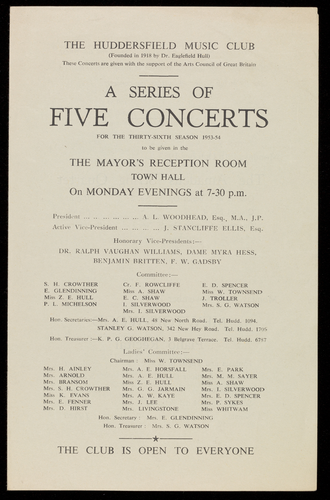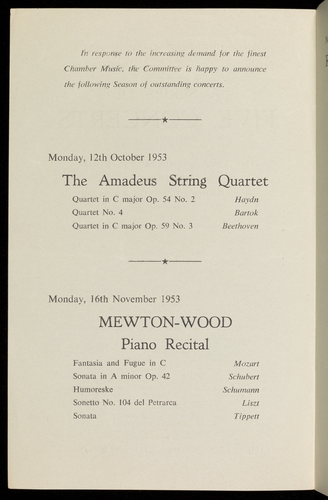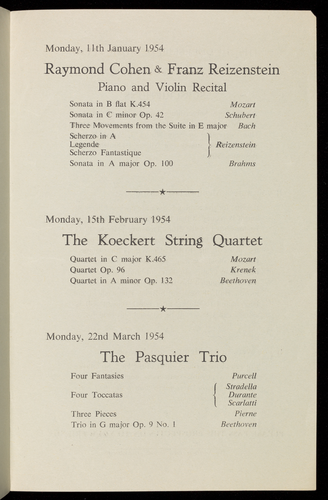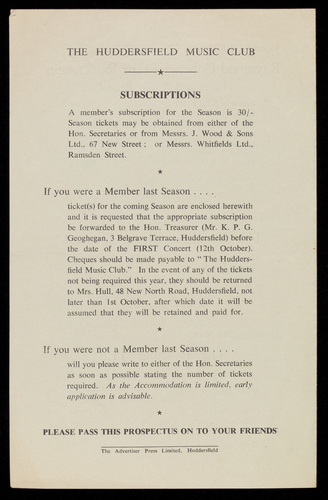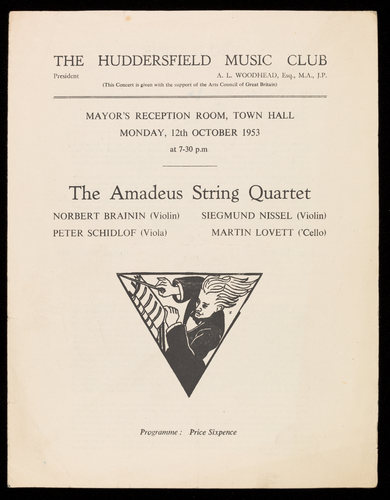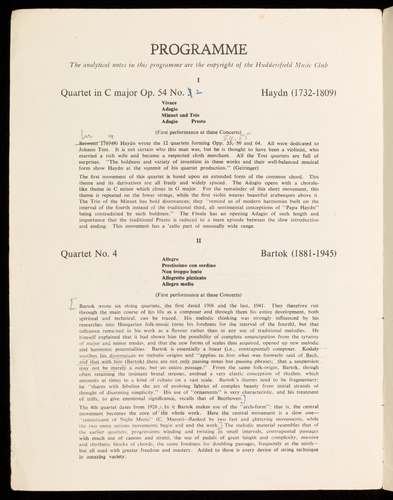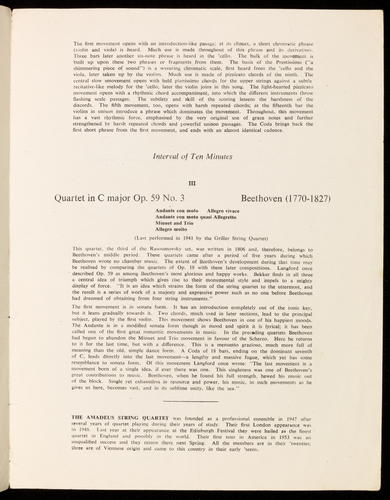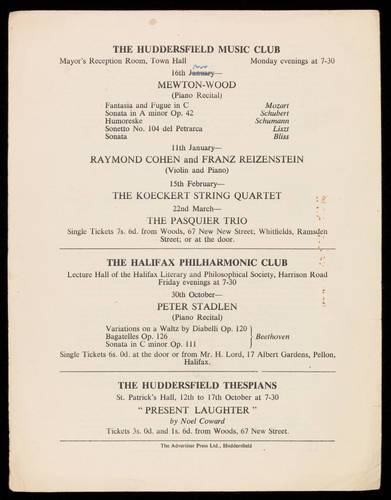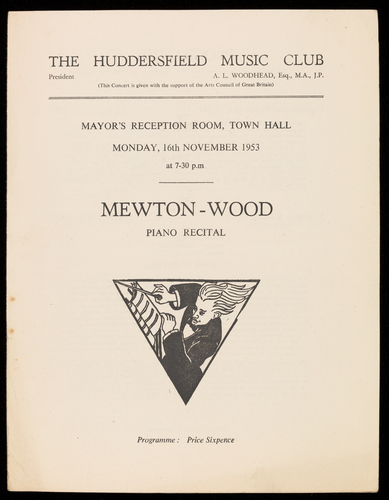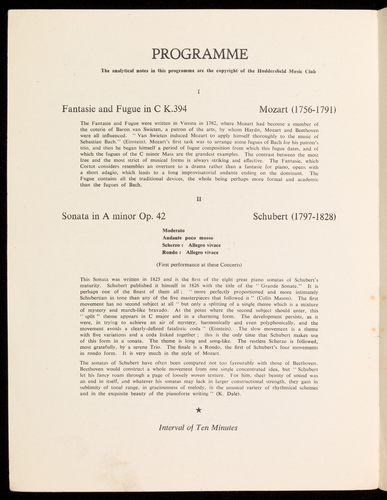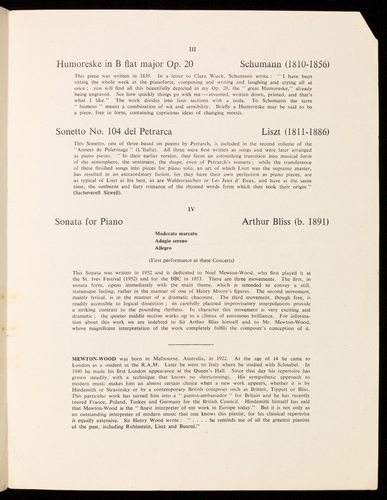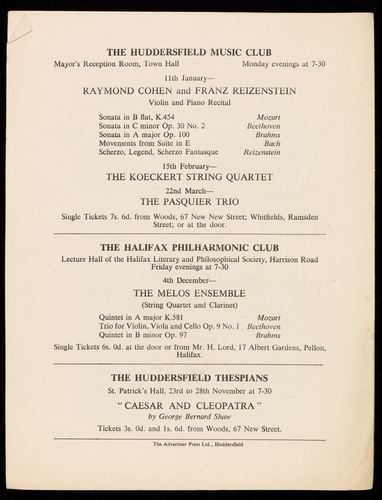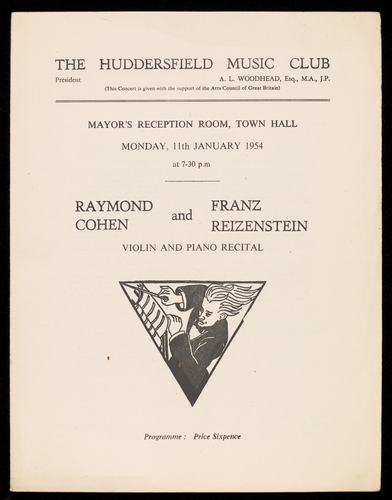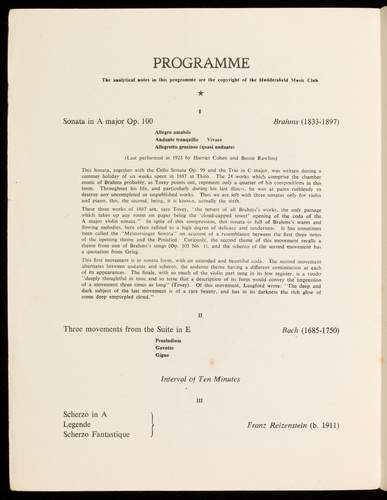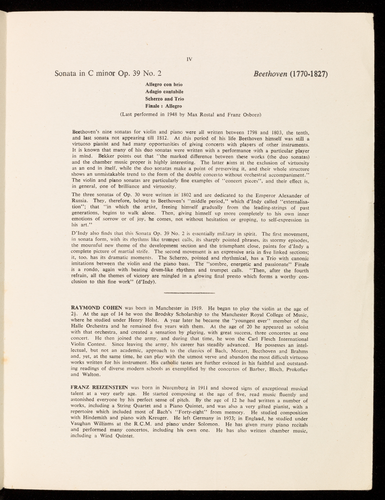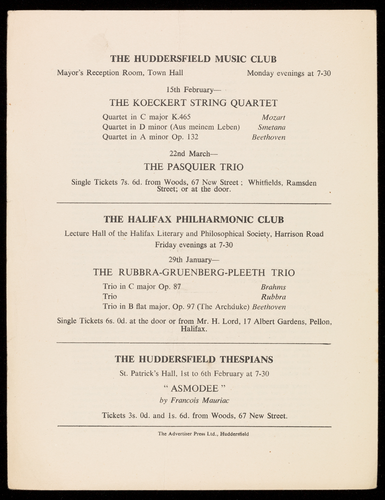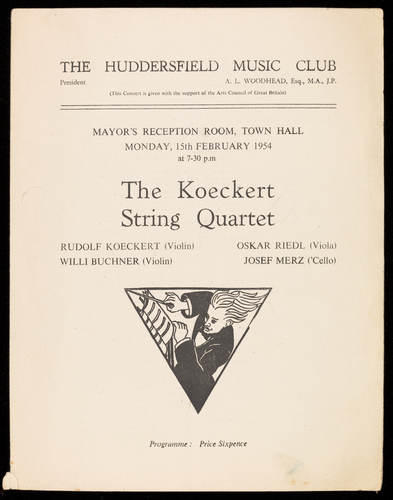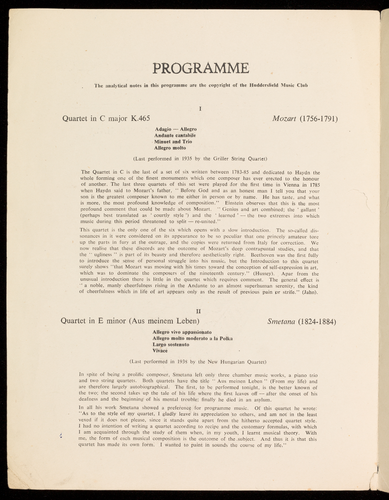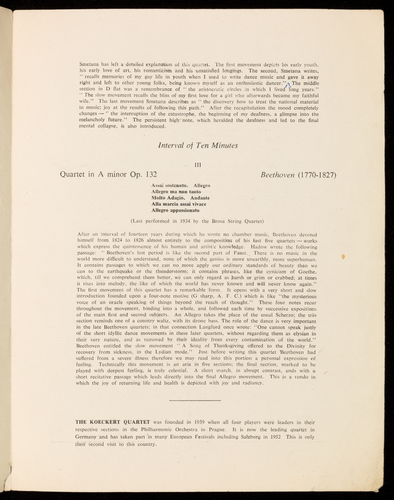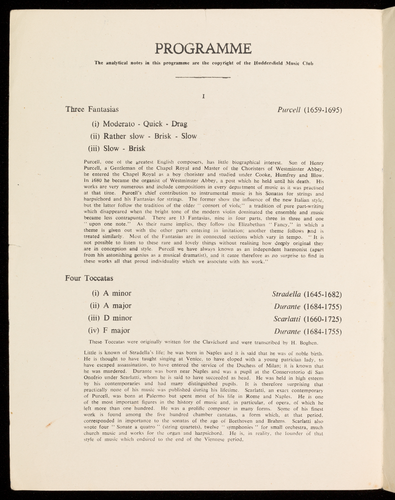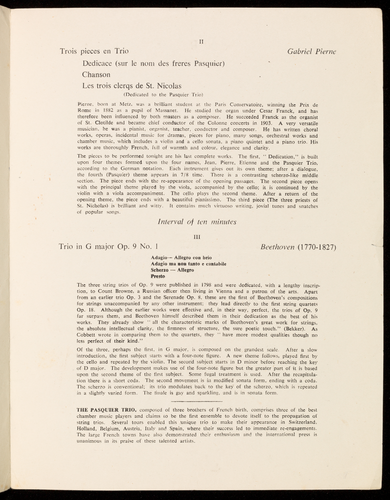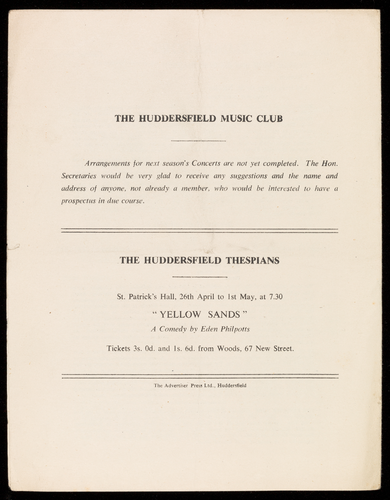Ocr'd Text:
THE HUDDERSFIELD MUSIC CLUB
(Founded in 1918 by Dr. Eaglefield Hull)
These Concerts are given with the support of the Arts Council of Great Britain
A SERIES OF
FIVE CONCERTS
FOR THE THIRTY-SIXTH SEASON 1953-54
to be given in the
THE MAYOR'S RECEPTION ROOM
TOWN HALL
On MONDAY EVENINGS at 7-30 p.m.
President
Active Vice-President ...
...
..1
...
S. H. CROWTHER
E. GLENDINNING
Miss Z. E. HULL
P. L. MICHELSON
...
...
A. L. WOODHEAD, Esq., M.A., J.P.
J. STANCLIFFE ELLIS, Esq.
Mrs. H. AINLEY
Mrs. ARNOLD
Mrs. BRANSOM
Mrs. S. H. CROWTHER
Miss K. EVANS
Mrs. E. FENNER
Mrs. D. HIRST
...
Honorary Vice-Presidents:--
DR. RALPH VAUGHAN WILLIAMS, DAME MYRA HESS,
BENJAMIN BRITTEN, F. W. GADSBY
...
Committee:-
Cr. F. ROWCLIFFE
Miss A. SHAW
E. C. SHAW
I. SILVERWOOD
Mrs. I. SILVERWOOD
E. D. SPENCER
Miss W. TOWNSEND
J. TROLLER
Mrs. S. G. WATSON
Hon. Secretaries:-Mrs. A. E. HULL, 48 New North Road. Tel. Hudd. 1094.
STANLEY G. WATSON, 342 New Hey Road. Tel. Hudd. 1706
Hon. Treasurer:-K. P. G. GEOGHEGAN, 3 Belgrave Terrace. Tel. Hudd. 6787
Ladies' Committee:-
Chairman : Miss W. TOWNSEND
Mrs. A. E. HORSFALL
Mrs. A. E. HULL
Miss Z. E. HULL
Mrs. G. G. JARMAIN
Mrs. A. W. KAYE
Mrs. J. LEE
Mrs. LIVINGSTONE
Hon. Secretary: Mrs. E. GLENDINNING
Hon. Treasurer: Mrs. S. G. WATSON
Mrs. E. PARK
Mrs. M. M. SAYER
Miss A. SHAW
Mrs. I. SILVERWOOD
Mrs. E. D. SPENCER
Mrs. P. SYKES
Miss WHITWAM
★
THE CLUB IS OPEN TO EVERYONE
Ocr'd Text:
In response to the increasing demand for the finest
Chamber Music, the Committee is happy to announce
the following Season of outstanding concerts.
Monday, 12th October 1953
The Amadeus String Quartet
Quartet in C major Op. 54 No. 2
Haydn
Quartet No. 4
Bartok
Quartet in C major Op. 59 No. 3
Beethoven
Monday, 16th November 1953
MEWTON-WOOD
Piano Recital
Fantasia and Fugue in C
Sonata in A minor Op. 42
Humoreske
Sonetto No. 104 del Petrarca
Sonata
Mozart
Schubert
Schumann
Liszt
Tippett
F
Ocr'd Text:
Monday, 11th January 1954
Raymond Cohen & Franz Reizenstein
Piano and Violin Recital
Sonata in B flat K.454
Sonata in C minor Op. 42
Three Movements from the Suite in E major Bach
Scherzo in A
Legende
Scherzo Fantastique
Sonata in A major Op. 100
-
Quartet in C major K.465
Quartet Op. 96
Quartet in A minor Op. 132
Monday, 22nd March 1954
Monday, 15th February 1954
The Koeckert String Quartet
Four Fantasies
Four Toccatas
Mozart
Schubert
Reizenstein
The Pasquier Trio
Three Pieces
Trio in G major Op. 9 No. 1
Brahms
Mozart
Krenek
Beethoven
Purcell
Stradella
Durante
Scarlatti
Pierne
Beethoven
Ocr'd Text:
THE HUDDERSFIELD MUSIC CLUB
SUBSCRIPTIONS
A member's subscription for the Season is 30/-
Season tickets may be obtained from either of the
Hon. Secretaries or from Messrs. J. Wood & Sons.
Ltd., 67 New Street; or Messrs. Whitfields Ltd...
Ramsden Street.
If you were a Member last Season ..
ticket(s) for the coming Season are enclosed herewith
and it is requested that the appropriate subscription
be forwarded to the Hon. Treasurer (Mr. K. P. G.
Geoghegan, 3 Belgrave Terrace, Huddersfield) before
the date of the FIRST Concert (12th October).
Cheques should be made payable to "The Hudders-
field Music Club." In the event of any of the tickets
not being required this year, they should be returned
to Mrs. Hull, 48 New North Road, Huddersfield, not
later than 1st October, after which date it will be
assumed that they will be retained and paid for.
If you were not a Member last Season . .
will you please write to either of the Hon. Secretaries
as soon as possible stating the number of tickets
required. As the Accommodation is limited, early
application is advisable.
★
PLEASE PASS THIS PROSPECTUS ON TO YOUR FRIENDS
The Advertiser Press Limited, Huddersfield
Ocr'd Text:
THE HUDDERSFIELD MUSIC CLUB
President
A. L. WOODHEAD, Esq., M.A., J.P.
(This Concert is given with the support of the Arts Council of Great Britain)
MAYOR'S RECEPTION ROOM, TOWN HALL
MONDAY, 12th OCTOBER 1953
at 7-30 p.m
The Amadeus String Quartet
SIEGMUND NISSEL (Violin)
MARTIN LOVETT ('Cello)
NORBERT BRAININ (Violin)
PETER SCHIDLOF (Viola)
Programme Price Sixpence
Ocr'd Text:
PROGRAMME
The analytical notes in this programme are the copyright of the Huddersfield Music Club
I
Quartet in C major Op. 54 No. 32
Vivace
Adagio
Minuet and Trio
Adagio
Presto
lu
(First performance at these Concerts)
Between 1789 90 Haydn wrote the 12 quartets forming Opp. 55, 56 and 64. All were dedicated to
Johann Tost. It is not certain who this man was, but he is thought to have been a violinist, who
married a rich wife and became a respected cloth merchant. All the Tost quartets are full of
surprises. "The boldness and variety of invention in these works and their well-balanced musical
form show Haydn at the summit of his quartet production." (Geiringer)
Quartet No. 4
The first movement of this quartet is based upon an extended form of the common chord. This
theme and its derivatives are all freely and widely spaced. The Adagio opens with a chorale-
like theme in C minor which closes in G major. For the remainder of this short movement, this
theme is repeated on the lower strings, while the first violin weaves beautiful arabesques above it.
The Trio of the Minuet has bold dissonances; they "remind us of modern harmonies built on the
interval of the fourth instead of the traditional third, all sentimental conceptions of "Papa Haydn"
being contradicted by such boldness." The Finale has an opening Adagio of such length and
importance that the traditional Presto is reduced to a mere episode between the slow introduction
and ending. This movement has a 'cello part of unusually wide range.
II
Haydn (1732-1809)
Allegro
Prestissimo con sordino
Non troppo lento
Allegretto pizzicato
Allegro molto
66
Bartok (1881-1945)
(First performance at these Concerts)
[
Bartok wrote six string quartets, the first dated 1908 and the last, 1941. They therefore run
through the main course of his life as a composer and through them his entire development, both
spiritual and technical, can be traced. His melodic thinking was strongly influenced by his
researches into Hungarian folk-music (note his fondness for the interval of the fourth), but that
influence remained in his work as a flavour rather than in any use of traditional melodies. He
himself explained that it had shown him the possibility of complete emancipation from the tyranny
of major and minor modes, and that the new forms of scales thus acquired, opened up new melodic
and harmonic potentialities. Bartok is essentially a linear (i.e., contrapuntal) composer. Kodaly
ascribes his dissonances to melodie origins and applies to him what was formerly said of Bach,
and that with him (Bartok) there are not only passing notes but passing phrases; that a suspension
may not be merely a note, but an entire passage." From the same folk-origin, Bartok, though
often retaining the insistant brutal stresses, evolved a very elastic conception of rhythm, which
amounts at times to a kind of rubato on a vast scale. Bartok's themes tend to be fragmentary;
he "shares with Sibelius the art of evolving fabrics of complex beauty from initial strands of
thought of disarming simplicity." His use of "ornaments" is very characteristic, and his treatment
of trills, to give emotional significance, recalls that of Beethoven.
The 4th quartet dates from 1928. In it Bartok makes use of the "arch-form"; that is, the central
movement becomes the core of the whole work. Here the central movement is a slow one-
"reminiscent of Night Music" (C. Mason)-flanked by two fast and glittering movements, while
the two more serious movements begin and end the work. The melodic material resembles that of
the earlier quartets; progressions winding and twisting in small intervals, contrapuntal passages
with much use of canons and stretti, the use of pedals of great length and complexity, massive
and rhythmic blocks of chords, the same fondness for doubling passages, frequently at the ninth-
but all used with greater freedom and mastery. Added to these is every device of string technique
in amazing variety.
Ocr'd Text:
The first movement opens with an introduction-like pasage; at its climax, a short chromatic phrase
(violin and viola) is heard. Much use is made throughout of this phrase and its derivatives.
Three bars later another six-note phrase is heard in the 'cello. The bulk of the movement is
built up upon these two phrases or fragments from them. The basis of the Prestissimo ("a
shimmering piece of sound") is a wavering chromatic scale, first heard from the 'cello and the
viola, later taken up by the violins. Much use is made of pizzicato chords of the ninth. The
central slow smovement opens with held pianissimo chords for the upper strings against a subtle
recitative-like melody for the 'cello; later the violin joins in this song. The light-hearted pizzicato
movement opens with a rhythmic chord accompaniment, into which the different instruments throw
flashing scale passages. The subtlety and skill of the scoring lessens the harshness of the
discords. The fifth movement, too, opens with harsh repeated chords; at the fifteenth bar the
violins in unison introduce a phrase which dominates the movement. Throughout, this movement
has a vast rhythmic force, emphasised by the very original use of grace notes and further
strengthened by harsh repeated chords and powerful unison passages. The Coda brings back the
first short phrase from the first movement, and ends with an almost identical cadence.
Interval of Ten Minutes
Quartet in C major Op. 59 No. 3
III
Beethoven (1770-1827)
Andante con moto Allegro vivace
Andante con moto quasi Allegretto
Minuet and Trio
Allegro molto
performed in 1941 by the Griller String Quartet)
(Last
This quartet, the third of the Rasoumovsky set, was written in 1806 and, therefore, belongs to
Beethoven's middle period. These quartets came after a period of five years during which
Beethoven wrote no chamber music. The extent of Beethoven's development during that time may
be realised by comparing the quartets of Op. 18 with these later compositions. Langford once
described Op. 59 as among Beethoven's most glorious and happy works. Bekker finds in all three
a central idea of triumph which gives rise to their monumental style and impels to a mighty
display of force. "It is an idea which strains the form of the string quartet to the uttermost, and
the result is a series of work of a majesty and expressive power such as no one before Beethoven
had dreamed of obtaining from four string instruments."
The first movement is in sonata form. It has an introduction completely out of the tonic key,
but it leans gradually towards it. Two chords, much used in later sections, lead to the principal
subject, played by the first violin. This movement shows Beethoven in one of his happiest moods.
The Andante is in a modified sonata form though in mood and spirit it is lyrical; it has been
called one of the first great romantic movements in music. In the preceding quartets Beethoven
had begun to abandon the Minuet and Trio movement in favour of the Scherzo. Here he returns
to it for the last time, but with a difference. This is a menuetto grazioso, much more full of
meaning than the old, simple dance form. A Coda of 18 bars, ending on the dominant seventh
of C, leads directly into the last movement-a lengthy and massive fugue, which yet has some
resemblance to sonata form. Of this movement Langford once wrote: "The last movement is a
movement born of a single idea, if ever there was one. This singleness was one of Beethoven's
great contributions to music. Beethoven, when he found his full strength, hewed his music out
of the block. Single yet exhaustless in resource and power, his music, in such movements as he
gives us here, becomes vast, and in its sublime unity, like the sea."
THE AMADEUS STRING QUARTET was founded as a professional ensemble in 1947 after
several years of quartet playing during their years of study. Their first London appearance was
in 1948. Last year at their appearance at the Edinburgh Festival they were hailed as the finest
quartet in England and possibly in the world. Their first tour in America in 1953 was an
unqualified success and they return there next Spring. All the members are in their 'twenties;
three are of Viennese origin and came to this country in their early 'teens.
Ocr'd Text:
THE HUDDERSFIELD MUSIC CLUB
Mayor's Reception Room, Town Hall
16th January-
MEWTON-WOOD
(Piano Recital)
Fantasia and Fugue in C
Sonata in A minor Op. 42
Humoreske
Sonetto No. 104 del Petrarca
Sonata
Monday evenings at 7-30
Mozart
Schubert
Schumann
Liszt
Bliss
11th January-
RAYMOND COHEN and FRANZ REIZENSTEIN
(Violin and Piano)
15th February-
THE KOECKERT STRING QUARTET
22nd March-
THE PASQUIER TRIO
Single Tickets 7s. 6d. from Woods, 67 New New Street; Whitfields, Ramsden
Street; or at the door.
The Advertiser Press Ltd., Huddersfield
THE HALIFAX PHILHARMONIC CLUB
Lecture Hall of the Halifax Literary and Philosophical Society, Harrison Road
Friday evenings at 7-30
30th October-
PETER STADLEN
(Piano Recital)
Variations on a Waltz by Diabelli Op. 120
Bagatelles Op. 126
Sonata in C minor Op. 111
Single Tickets 6s. Od. at the door or from Mr. H. Lord, 17 Albert Gardens, Pellon,
Halifax.
Beethoven
THE HUDDERSFIELD THESPIANS
St. Patrick's Hall, 12th to 17th October at 7-30
" PRESENT LAUGHTER "
by Noel Coward
Tickets 3s. Od. and 1s. 6d. from Woods, 67 New Street.
18
im!
Ocr'd Text:
THE HUDDERSFIELD MUSIC CLUB
President
A. L. WOODHEAD, Esq., M.A., J.P.
(This Concert is given with the support of the Arts Council of Great Britain)
MAYOR'S RECEPTION ROOM, TOWN HALL
MONDAY, 16th NOVEMBER 1953
at 7-30 p.m.
MEWTON-WOOD
PIANO RECITAL
Programme: Price Sixpence
Ocr'd Text:
PROGRAMME
The analytical notes in this programme are the copyright of the Huddersfield Music Club
66
Fantasie and Fugue in C K.394
Mozart (1756-1791)
The Fantasie and Fugue were written in Vienna in 1782, where Mozart had become a member of
the coterie of Baron van Swieten, a patron of the arts, by whom Haydn, Mozart and Beethoven
were all influenced. Van Swieten induced Mozart to apply himself thoroughly to the music of
Sebastian Bach." (Einstein). Mozart's first task was to arrange some fugues of Bach for his patron's
trio, and then he began himself a period of fugue composition from which this fugue dates, and of
which the fugues of the C minor Mass are the grandest examples. The contrast between the most
free and the most strict of musical forms is always striking and effective. The Fantasie, which
Cortot considers resembles an overture to a drama rather than a fantasie for piano, opens with
a short adagio, which leads to a long improvisatorial andante ending on the dominant.
Fugue contains all the traditional devices, the whole being perhaps more formal and academic
than the fugues of Bach.
The
I
Sonata in A minor Op. 42
II
Moderato
Andante poco mosso
Scherzo Allegro vivace
Rondo Allegro vivace
(First performance at these Concerts)
66
This Sonata was written in 1825 and is the first of the eight great piano sonatas of Schubert's
maturity. Schubert published it himself in 1826 with the title of the "Grande Sonate." It is
perhaps one of the finest of them all ; "more perfectly proportioned and more intimately
Schubertian in tone than any of the five masterpieces that followed it" (Colin Mason). The first
movement has no second subject at all" but only a splitting of a single theme which is a mixture
of mystery and march-like bravado. At the point where the second subject should enter, this
split" theme appears in C major and in a charming form. The development persists, as it
were, in trying to achieve an air of mystery, harmonically and even polyphonically, and the
movement avoids a clearly-defined fatalistic coda" (Einstein). The slow movement is a theme
with five variations and a coda linked together; this is the only time that Schubert makes use
of this form in a sonata. The theme is long and song-like. The restless Scherzo is followed,
most gratefully, by a serene Trio. The finale is a Rondo, the first of Schubert's four movements
in rondo form. It is very much in the style of Mozart.
Schubert (1797-1828)
The sonatas of Schubert have often been compared not too favourably with those of Beethoven.
Beethoven would construct a whole movement from one single concentrated idea, but "Schubert
let his fancy roam through a page of loosely woven texture. For him, sheer beauty of sound was
an end in itself, and whatever his sonatas may lack in larger constructional strength, they gain in
sublimity of tonal range, in graciousness of melody, in the unusual variety of rhythmical schemes
and in the exquisite beauty of the pianoforte writing (K. Dale).
99
★
Interval of Ten Minutes
Ocr'd Text:
III
Humoreske in B flat major Op. 20
Schumann (1810-1856)
66
This piece was written in 1839. In a letter to Clara Wieck, Schumann wrote: "I have been
sitting the whole week at the pianoforte, composing and writing and laughing and crying all at
you will find all this beautifully depicted in my Op. 20, the " great Humoreske," already
being engraved. See how quickly things go with me - invented, written down, printed, and that's
what I like." The work divides into four sections with a coda. To Schumann the term
meant a combination of wit and sensibility. Briefly a Humoreske may be said to be
a piece, free in form, containing capricious ideas of changing moods.
humour "
Sonetto No. 104 del Petrarca
Liszt (1811-1886)
This Sonetto, one of three based on poems by Petrarch, is included in the second volume of the
"Annees de Pelerinage" (L'Italie). All three were first written as songs and were later arranged
as piano pieces. "In their earlier version, they form an astonishing transition into musical form
of the atmosphere, the sentiment, the shape, even of Petrarch's sonnets; while the transference
of these finished songs into pieces for piano solo, an art of which Liszt was the supreme master,
has resulted in an extraordinary fusion, for they have their own perfection as piano pieces, are
as typical of Liszt at his best, as are Waldesrauchen or Les Jeux d' Eaux, and have at the same
time, the sunburnt and fiery romance of the rhymed words from which they took their origin
(Sacheverell Sitwell).
Sonata for Piano
IV
Moderato marcato
Adagio sereno
Allegro
(First performance at these Concerts)
This Sonata was written in 1952 and is dedicated to Noel Mewton-Wood, who first played it at
the St. Ives Festival (1952) and for the BBC in 1953. There are three movements. The first, in
sonata form, opens immediately with the main theme, which is intended to convey a still,
statuesque feeling, rather in the manner of one of Henry Moore's figures. The second movement,
mainly lyrical, is in the manner of a dramatic chaconne. The third movement, though free, is
readily accessible to logical dissection; its carefully planned improvisatory interpolations provide
a striking contrast to the pounding rhythms. In character this movement is very exciting and
dramatic; the quieter middle section works up to a climax of enormous brilliance. For informa-
tion about this work we are indebted to Sir Arthur Bliss himself and to Mr. Mewton-Wood,
whose magnificent interpretation of the work completely fulfils the composer's conception of it.
MEWTON-WOOD was born in Melbourne, Australia, in 1922. At the age of 14 he came to
London as a student at the R.A.M. Later he went to Italy where he studied with Schnabel. In
1940 he made his first London appearance at the Queen's Hall. Since that day his repertoire has
grown steadily, with a technique that knows no shortcomings. His sympathetic approach to
modern music makes him an almost certain choice when a new work appears, whether it is by
Hindemith or Stravinsky or by a contemporary British composer such as Britten, Tippett or Bliss.
This particular work has turned him into a "pianist-ambassador" for Britain and he has recently
toured France, Poland, Turkey and Germany for the British Council. Hindemith himself has said
that Mewton-Wood is the finest interpreter of my work in Europe today." But it is not only as
an outstanding interpreter of modern music that one knows this pianist, for his classical repertoire
he reminds me of all the greatest pianists
is equally extensive. Sir Henry Wood wrote:
of the past, including Rubinstein, Liszt and Busoni."
66
Arthur Bliss (b. 1891)
●
♦
Ocr'd Text:
THE HUDDERSFIELD MUSIC CLUB
Mayor's Reception Room, Town Hall
11th January-
Monday evenings at 7-30
RAYMOND COHEN and FRANZ REIZENSTEIN
Violin and Piano Recital
Sonata in B flat, K.454
Sonata in C minor Op. 30 No. 2
Sonata in A major Op. 100
Movements from Suite in E
Scherzo, Legend, Scherzo Fantasque
15th February-
THE KOECKERT STRING QUARTET
Mozart
Beethoven
Brahms
Bach
Reizenstein
22nd March-
THE PASQUIER TRIO
Single Tickets 7s. 6d. from Woods, 67 New New Street; Whitfields, Ramsden
Street; or at the door.
THE HALIFAX PHILHARMONIC CLUB
Lecture Hall of the Halifax Literary and Philosophical Society, Harrison Road
Friday evenings at 7-30
4th December-
THE MELOS ENSEMBLE
(String Quartet and Clarinet)
Quintet in A major K.581
Mozart
Trio for Violin, Viola and Cello Op. 9 No. 1 Beethoven
Quintet in B minor Op. 97
Brahms
Single Tickets 6s. Od. at the door or from Mr. H. Lord, 17 Albert Gardens, Pellon,
Halifax.
THE HUDDERSFIELD THESPIANS
St. Patrick's Hall, 23rd to 28th November at 7-30
"CAESAR AND CLEOPATRA "
by George Bernard Shaw
Tickets 3s. Od. and 1s. 6d. from Woods, 67 New Street.
The Advertiser Press Ltd., Huddersfield
Ocr'd Text:
THE HUDDERSFIELD MUSIC CLUB
President
A. L. WOODHEAD, Esq., M.A., J.P.
(This Concert is given with the support of the Arts Council of Great Britain)
MAYOR'S RECEPTION ROOM, TOWN HALL
MONDAY, 11th JANUARY 1954
at 7-30 p.m.
RAYMOND
COHEN
and
FRANZ
REIZENSTEIN
VIOLIN AND PIANO RECITAL
Programme Price Sixpence
Ocr'd Text:
The analytical notes in this programme are the copyright of the Huddersfield Music Club
Sonata in A major Op. 100
PROGRAMME
I
Allegro amabile
Andante tranquillo Vivace
Allegretto grazioso (quasi andante)
(Last performed in 1923 by Harriet Cohen and Bessie Rawlins)
This Sonata, together with the Cello Sonata Op. 99 and the Trio in C major, was written during a
summer holiday of six weeks spent in 1887 at Thun. The 24 works which comprise the chamber
music of Brahms probably, as Tovey points out, represent only a quarter of his compositions in this
form. Throughout his life, and particularly during his last illness, he was at pains ruthlessly to
destroy any uncompleted or unpublished works. Thus we are left with three sonatas only for violin
and piano, this, the second, being, it is known, actually the sixth.
These three works of 1887 are, says Tovey, "the tersest of all Brahms's works, the only passage
which takes up any room on paper being the 'cloud-capped tower' opening of the coda of the
A major violin sonata." In spite of this compression, this sonata is full of Brahms's warm and
flowing melodies, here often refined to a high degree of delicacy and tenderness. It has sometimes
been called the "Meistersinger Sonata" on account of a resemblance between the first three notes
of the opening theme and the Preislied. Curiously, the second theme of this movement recalls a
theme from one of Brahms's songs (Op. 105 No. 1), and the scherzo of the second movement has
a quotation from Grieg.
Three movements from the Suite in E
Praeludium
Gavotte
Gigue
Scherzo in A
Legende
Scherzo Fantastique
This first movement is in sonata form, with an extended and beautiful coda. The second movement
alternates between andante and scherzo, the andante theme having a different continuation at each
of its appearances. The finale, with so much of the violin part sung in its low register, is a rondo
"deeply thoughtful in tone and so terse that a description of its form would convey the impression
of a movement three times as long" (Tovey). Of this movement, Langford wrote: "The deep and
dark subject of the last movement is of a rare beauty, and has in its darkness the rich glow of
some deep empurpled cloud,"
Brahms (1833-1897)
II
Interval of Ten Minutes
III
Bach (1685-1750)
Franz Reizenstein (b. 1911)
Ocr'd Text:
Sonata in C minor Op. 39 No. 2
IV
Beethoven (1770-1827)
Allegro con brio
Adagio cantabile
Scherzo and Trio
Finale: Allegro
(Last performed in 1948 by Max Rostal and Franz Osborn)
Beethoven's nine sonatas for violin and piano were all written between 1798 and 1803, the tenth,
and last sonata not appearing till 1812. At this period of his life Beethoven himself was still a
virtuoso pianist and had many opportunities of giving concerts with players of other instruments.
It is known that many of his duo sonatas were written with a performance with a particular player
in mind. Bekker points out that "the marked difference between these works (the duo sonatas)
and the chamber music proper is highly interesting. The latter aims at the exclusion of virtuosity
as an end in itself, while the duo sonatas make a point of preserving it, and their whole structure
shows an unmistakable trend to the form of the double concetto without orchestral accompaniment.'
The violin and piano sonatas are particularly fine examples of "concert pieces", and their effect is,
in general, one of brilliance and virtuosity.
The three sonatas of Op. 30 were written in 1802 and are dedicated to the Emperor Alexander of
Russia. They, therefore, belong to Beethoven's "middle period," which d'Indy called "externalisa-
tion"; that "in which the artist, freeing himself gradually from the leading-strings of past
generations, begins to walk alone. Then, giving himself up more completely to his own inner
emotions of sorrow or of joy, he comes, not without hesitation or groping, to self-expression in
his art."
D'Indy also finds that this Sonata Op. 39 No. 2 is essentially military in spirit. The first movement,
in sonata form, with its rhythms like trumpet calls, its sharply pointed phrases, its stormy episodes,
the mournful new theme of the development section and the triumphant close, paints for d'Indy a
complete picture of martial strife. The second movement is an expressive aria in five linked sections;
it, too, has its dramatic moments. The Scherzo, pointed and rhythmical, has a Trio with canonic
imitations between the violin and the piano bass. The "sombre, energetic and passionate" Finale
is a rondo, again with beating drum-like rhythms and trumpet calls. "Then, after the fourth
refrain, all the themes of victory are mingled in a glowing final presto which forms a worthy con-
clusion to this fine work" (d'Indy).
RAYMOND COHEN was born in Manchester in 1919. He began to play the violin at the age of
2. At the age of 14 he won the Brodsky Scholarship to the Manchester Royal College of Music,
where he studied under Henry Holst. A year later he became the "youngest ever" member of the
Halle Orchestra and he remained five years with them. At the age of 20 he appeared as soloist
with that orchestra, and created a sensation by playing, with great success, three concertos at one
concert. He then joined the army, and during that time, he won the Carl Flesch International
Violin Contest. Since leaving the army, his career has steadily advanced. He possesses an intel-
lectual, but not an academic, approach to the classics of Bach, Mozart, Beethoven and Brahms
and, yet, at the same time, he can play with the utmost verve and abandon the most difficult virtuoso
works written for his instrument. His catholic tastes are further evinced in his faithful and outstand-
ing readings of diverse modern schools as exemplified by the concertos of Barber, Bloch, Prokofiev
and Walton.
FRANZ REIZENSTEIN was born in Nuremberg in 1911 and showed signs of exceptional musical
talent at a very early age. He started composing at the age of five, read music fluently and
astonished everyone by his perfect sense of pitch. By the age of 12 he had written a number of
works, including a String Quartet and a Piano Quintet, and was also a very gifted pianist, with a
repertoire which included most of Bach's "Forty-eight" from memory. He studied composition
with Hindemith and piano with Kreuger. He left Germany in 1933; in England, he studied under
Vaughan Williams at the R.C.M. and piano under Solomon. He has given many piano recitals
and performed many concertos, including his own one. He has also written chamber music,
including a Wind Quintet.
Ocr'd Text:
THE HUDDERSFIELD MUSIC CLUB
Mayor's Reception Room, Town Hall
Monday evenings at 7-30
15th February-
THE KOECKERT STRING QUARTET
Quartet in C major K.465
Quartet in D minor (Aus meinem Leben)
Quartet in A minor Op. 132
Mozart
Smetana
Beethoven
22nd March-
THE PASQUIER TRIO
Single Tickets 7s. 6d. from Woods, 67 New Street; Whitfields, Ramsden
Street; or at the door.
THE HALIFAX PHILHARMONIC CLUB
Lecture Hall of the Halifax Literary and Philosophical Society, Harrison Road
Friday evenings at 7-30
29th January-
THE RUBBRA-GRUENBERG-PLEETH TRIO
Trio in C major Op. 87
Trio
Trio in B flat major, Op. 97 (The Archduke) Beethoven
Brahms
Rubbra
Single Tickets 6s. Od. at the door or from Mr. H. Lord, 17 Albert Gardens, Pellon,
Halifax.
The Advertiser Press Ltd., Huddersfield
THE HUDDERSFIELD THESPIANS
St. Patrick's Hall, 1st to 6th February at 7-30
" ASMODEE "
by Francois Mauriac
Tickets 3s. Od. and 1s. 6d. from Woods, 67 New Street.
Ocr'd Text:
THE HUDDERSFIELD MUSIC
MUSIC CLUB
President
A. L. WOODHEAD, Esq., M.A., J.P.
(This Concert is given with the support of the Arts Council of Great Britain)
MAYOR'S RECEPTION ROOM, TOWN HALL
MONDAY, 15th FEBRUARY 1954
at 7-30 p.m
The Koeckert
String Quartet
RUDOLF KOECKERT (Violin)
WILLI BUCHNER (Violin)
OSKAR RIEDL (Viola)
JOSEF MERZ ('Cello)
Programme: Price Sixpence
Ocr'd Text:
Quartet in C major K.465
PROGRAMME
The analytical notes in this programme are the copyright of the Huddersfield Music Club
6.
I
11
Adagio Allegro
Andante cantabile
Minuet and Trio
Allegro molto
(Last performed in 1935 by the Griller String Quartet)
The Quartet in C is the last of a set of six written between 1783-85 and dedicated to Haydn the
whole forming one of the finest monuments which one composer has ever erected to the honour
of another. The last three quartets of this set were played for the first time in Vienna in 1785
when Haydn said to Mozart's father, "Before God and as an honest man I tell you that your
son is the greatest composer known to me either in person or by name. He has taste, and what
is more, the most profound knowledge of composition." Einstein observes that this is the most
profound comment that could be made about Mozart. "Genius and art combined; the gallant
(perhaps best translated as courtly style') and the learned the two extremes into which
music during this period threatened to split -re-united."
6
-
This quartet is the only one of the six which opens with a slow introduction. The so-called dis-
sonances in it were considered on its appearance to be so peculiar that one princely amateur tore
up the parts in fury at the outrage, and the copies were returned from Italy for correction. We
now realise that these discords are the outcome of Mozart's deep contrapuntal studies, and that
the ugliness is part of its beauty and therefore aesthetically right. Beethoven was the first fully
to introduce the sense of personal struggle into his music, but the Introduction to this quartet
surely shows that Mozart was moving with his times toward the conception of self-expression in art,
which was to dominate the composers of the nineteenth century." (Hussey). Apar from the
unusual introduction there is little in the quartet which requires comment. The general effect is
II
Mozart (1756-1791)
.6
a noble, manly cheerfulness rising in the Andante to an almost superhuman serenity, the kind
of cheerfulness which in life of art appears only as the result of previous pain or strife." (Jahn).
Quartet in E minor (Aus meinem Leben)
Allegro vivo appassionato
Allegro molto moderato a la Polka
Largo sostenuto
Vivace
(Last performed in 1938 by the New Hungarian Quartet)
In spite of being a prolific composer, Smetana left only three chamber music works, a piano trio
and two string quartets. Both quartets have the title "Aus meinen Leben" (From my life) and
are therefore largely autobiographical. The first, to be performed tonight, is the better known of
the two; the second takes up the tale of his life where the first leaves off after the onset of his
deafness and the beginning of his mental trouble; finally he died in an asylum.
--
-
Smetana (1824-1884)
In all his work Smetana showed a preference for programme music. Of this quartet he wrote:
"As to the style of my quartet, I gladly leave its appreciation to others, and am not in the least
vexed if it does not please, since it stands quite apart from the hitherto accepted quartet style.
I had no intention of writing a quartet according to recipe and the customary formulas, with which
I am acquainted through the study of them when, in my youth, I learnt musical theory. With
me, the form of each musical composition is the outcome of the subject. And thus it is that this
quartet has made its own form. I wanted to paint in sounds the course of my life."
Ocr'd Text:
Smetana has left a detailed explanation of this quartet. The first movement depicts his early youth,
his early love of art, his romanticism and his unsatisfied longings. The second, Smetana writes,
"recalls memories of my gay life in youth when I used to write dance music and gave it away
right and left to other young folks, being known myself as an enthusiastic dancer." The middle
section in D flat was a remembrance of the aristocratic circles in which I lived long years."
"The slow movement recalls the bliss of my first love for a girl who afterwards became my faithful
wife." The last movement Smetana describes as the discovery how to treat the national material
in music; joy at the results of following this path." After the recapitulation the mood completely
changes- the interruption of the catastrophe, the beginning of my deafness, a glimpse into the
melancholy future." The persistent high note, which heralded the deafness and led to the final
mental collapse, is also introduced.
Quartet in A minor Op. 132
Interval of Ten Minutes
III
Beethoven (1770-1827)
Assai sostenuto. Allegro
Allegro ma non tanto
Molto Adagio. Andante
Alla marcia assai vivace
Allegro appassionato
(Last performed in 1934 by the Brosa String Quartet)
After an interval of fourteen years during which he wrote no chamber music, Beethoven devoted
himself from 1824 to 1826 almost entirely to the composition of his last five quartets - works
which express the quintessence of his human and artistic knowledge. Hadow wrote the following
passage: "Beethoven's last period is like the second part of Faust. There is no music in the
world more difficult to understand, none of which the genius is more unearthly, more superhuman.
It contains passages to which we can no more apply our ordinary standards of beauty than we
can to the earthquake or the thunderstorm; it contains phrases, like the cynicism of Goethe,
which, till we comprehend them better, we can only regard as harsh or grim or crabbed; at times
it rises into melody, the like of which the world has never known and will never know again."
The first movement of this quartet has a remarkable form. It opens with a very short and slow
introduction founded upon a four-note motive (G sharp, A. F. C.) which is like "the mysterious
voice of an oracle speaking of things beyond the reach of thought." These four notes recur
throughout the movement, binding into a whole, and followed each time by successive expositions
of the main first and second subjects. An Allegro takes the place of the usual Scherzo; the trio
section reminds one of a country waltz, with its drone bass. The role of the dance is very important
in the late Beethoven quartets; in that connection Langford once wrote: "One cannot speak justly
of the short idyllic dance movements in these later quartets, without regarding them as elysian in
their very nature, and as removed by their ideality from every contamination of the world."
Beethoven entitled the slow movement "A Song of Thanksgiving offered to the Divinity for
recovery from sickness, in the Lydian mode." Just before writing this quartet Beethoven had
suffered from a severe illness therefore we may read into this portion a personal expression of
feeling. Technically this movement is an aria in five sections; the final section, marked to be
played with deepest feeling, is truly celestial. A short march, in abrupt contrast, ends with a
short recitative passage which leads directly into the final Allegro movement. This is a rondo in
which the joy of returning life and health is depicted with joy and radiancy.
66
THE KOECKERT QUARTET was founded in 1939 when all four players were leaders in their
respective sections in the Philharmonic Orchestra in Prague. It is now the leading quartet in
Germany and has taken part in many European Festivals including Salzburg in 1952 This is only
their second visit to this country.
Ocr'd Text:
THE HUDDERSFIELD MUSIC CLUB
Mayor's Reception Room, Town Hall
22nd March-
THE PASQUIER TRIO
Three Fantasies
Four Toccatas
Purcell
Stradella, Durante and Scarlatti
Pierne
Beethoven
Three Pieces
Trio in G major Op. 9 No. 1
Monday evenings at 7-30
Single Tickets 7s. 6d. from Woods, 67 New Street; Whitfields, Ramsden
Street; or at the door.
THE HALIFAX PHILHARMONIC CLUB
Lecture Hall of the Halifax Literary and Philosophical Society, Harrison Road
Friday evenings at 7-30
19th March-
THE BARYLLI STRING QUARTET
Quartet in D minor (Death and the Maiden) Schubert.
Quartet Op. 10 No. 2
Kodaly
Quartet in C sharp minor Op. 131
Beethoven
Single Tickets 6s. Od. at the door.
THE HUDDERSFIELD THESPIANS
St. Patrick's Hall, 8th to 15th March, at 7.30
"THE MAN ABOUT THE HOUSE"
by Brett Young
Tickets 3s. Od. and 1s. 6d. from Woods, 67 New Street.
The Advertiser Press Ltd., Huddersfield
Ocr'd Text:
THE HUDDERSFIELD MUSIC CLUB
President
A. L. WOODHEAD, Esq., M.A., J.P.
(This Concert is given with the support of the Arts Council of Great Britain)
MAYOR'S RECEPTION ROOM, TOWN HALL
MONDAY, 22nd. MARCH 1954
at 7-30 p.m
The Pasquier Trio
JEAN PASQUIER (Violin)
PIERRE PASQUIER (Viola)
ETIENNE PASQUIER (Cello)
Programme: Price Sixpence
Ocr'd Text:
PROGRAMME
The analytical notes in this programme are the copyright of the Huddersfield Music Club
Three Fantasias
(i) Moderato - Quick - Drag
(ii) Rather slow - Brisk - Slow
(iii) Slow - Brisk
I
Purcell, one of the greatest English composers, has little biographical interest. Son of Henry
Purcell, a Gentleman of the Chapel Royal and Master of the Choristers of Westminster Abbey,
he entered the Chapel Royal as a boy chorister and studied under Cooke, Humfrey and Blow.
in 1680 he became the organist of Westminster Abbey, a post which he held until his death. His
works are very numerous and include compositions in every department of music as it was practised
at that time. Purcell's chief contribution to instrumental music is his Sonatas for strings and
harpsichord and his Fantasias for strings. The former show the influence of the new Italian style,
but the latter follow the tradition of the older consort of viols;" a tradition of pure part-writing
which disappeared when the bright tone of the modern violin dominated the ensemble and music
became less contrapuntal. There are 13 Fantasias, nine in four parts, three in three and one
Four Toccatas
Purcell (1659-1695)
upon one note." As their name implies, they follow the Elizabethan "Fancy," in which a
theme is given out with the other parts entering in imitation; another theme follows and is
treated similarly. Most of the Fantasias are in connected sections which vary in tempo. "It is
not possible to listen to these rare and lovely things without realising how deeply original they
are in conception and style. Purcell we have always known as an independent harmonist (apart
from his astonishing genius as a musical dramatist), and it came therefore as no surprise to find in
these works all that proud individuality which we associate with his work."
(i) A minor
(ii) A major
(iii) D minor
Stradella (1645-1682)
Durante (1684-1755)
Scarlatti (1660-1725)
Durante (1684-1755)
(iv) F major
These Toccatas were originally written for the Clavichord and were transcribed by H. Boghen.
Little is known of Stradella's life; he was born in Naples and it is said that he was of noble birth.
He is thought to have taught singing at Venice, to have eloped with a young patrician lady, to
have escaped assassination, to have entered the service of the Duchess of Milan; it is known that
he was murdered. Durante was born near Naples and was a pupil at the Conservatorio di San
Onofrio under Scarlatti, whom he is said to have succeeded as head. He was held in high esteem
by his contemporaries and had many distinguished pupils.
It
is therefore surprising that
practically none of his music was published during his lifetime. Scarlatti, an exact contemporary
of Purcell, was born at Palermo but spent most of his life in Rome and Naples. He is one
of the most important figures in the history of music and, in particular, of opera, of which he
left more than one hundred. He was a prolific composer in many forms. Some of his finest
work is found among the five hundred chamber cantatas, a form which, at that period,
corresponded in importance to the sonatas of the age of Beethoven and Brahms. Scarlatti also
wrote four "Sonate a quatro" (string quartets), twelve symphonies" for small orchestra, much
church music and works for the organ and harpsichord. He is, in reality, the founder of that
style of music which endured to the end of the Viennese period.
66
Ocr'd Text:
Trois pieces en Trio
Dedicace (sur le nom des freres Pasquier)
Chanson
Les trois clerqs de St. Nicolas
II
(Dedicated to the Pasquier Trio)
Pierne, born at Metz, was a brilliant student at the Paris Conservatoire, winning the Prix de
Rome in 1882 as a pupil of Massanet. He studied the organ under Cesar Franck, and has
therefore been influenced by both masters as a composer. He succeeded Franck as the organist
of St. Clotilde and became chief conductor of the Colonne concerts in 1903. A very versatile
musician, he was a pianist, organist, teacher, conductor and composer. He has written choral
works, operas, incidental music for dramas, pieces for piano, many songs, orchestral works and
chamber music, which includes a violin and a cello sonata, a piano quintet and a piano trio. His
works are thoroughly French, full of warmth and colour, elegance and clarity.
Trio in G major Op. 9 No. 1
The pieces to be performed tonight are his last complete works. The first, "Dedication," is built
upon four themes formed upon the four names, Jean, Pierre, Etienne and the Pasquier Trio,
according to the German notation. Each instrument gives out its own theme; after a dialogue,
the fourth (Pasquier) theme appears in 7/8 time. There is a contrasting scherzo-like middle
section. The piece ends with the re-appearance of the opening passages. The second piece opens
with the principal theme played by the viola, accompanied by the cello; it is continued by the
violin with a viola accompaniment. The cello plays the second theme. After a return of the
opening theme, the piece ends with a beautiful pianissimo. The third piece (The three priests of
St. Nicholas) is brilliant and witty. It contains much virtuoso writing, jovial tunes and snatches
of popular songs.
Interval of ten minutes
III
Gabriel Pierne
Adagio Allegro con brio
Adagio ma non tanto e cantabile
Scherzo Allegro
Presto
66
Beethoven (1770-1827)
The three string trios of Op. 9 were published in 1798 and were dedicated, with a lengthy inscrip-
tion, to Count Browne, a Russian officer then living in Vienna and a patron of the arts. Apart
from an earlier trio Op. 3 and the Serenade Op. 8, these are the first of Beethoven's compositions
for strings unaccompanied by any other instrument; they lead directly to the first string quartets
Op. 18. Although the earlier works were effective and, in their way, perfect, the trios of Op. 9
far surpass them, and Beethoven himself described them in their dedication as the best of his
works. They already show all the characteristic marks of Beethoven's great work for strings,
the absolute intellectual clarity, the firmness of structure, the sure poetic touch." (Bekker). As
Cobbett wrote in comparing them to the quartets, they have more modest qualities though no
less perfect of their kind."
Of the three, perhaps the first, in G major, is composed on the grandest scale. After a slow
introduction, the first subject starts with a four-note figure. A new theme follows, played first by
the cello and repeated by the violin. The second subject starts in D minor before reaching the key
of D major. The development makes use of the four-note figure but the greater part of it is based
upon the second theme of the first subject. Some fugal treatment is used. After the recapitula-
tion there is a short coda. The second movement is in modified sonata form, ending with a coda.
The scherzo is conventional; its trio modulates back to the key of the scherzo, which is repeated
in a slightly varied form. The finale is gay and sparkling, and is in sonata form.
THE PASQUIER TRIO, composed of three brothers of French birth, comprises three of the best
chamber music players and claims to be the first ensemble to devote itself to the propagation of
string trios. Several tours enabled this unique trio to make their appearance in Switzerland,
Holland, Belgium, Austria, Italy and Spain, where their success led to immediate re-engagements.
The large French towns have also demonstrated their enthusiasm and the international press is
unanimous in its praise of these talented artists.
Ocr'd Text:
THE HUDDERSFIELD MUSIC CLUB
Arrangements for next season's Concerts are not yet completed. The Hon.
Secretaries would be very glad to receive any suggestions and the name and
address of anyone, not already a member, who would be interested to have a
prospectus in due course.
THE HUDDERSFIELD THESPIANS
St. Patrick's Hall, 26th April to 1st May, at 7.30
YELLOW SANDS"
A Comedy by Eden Philpotts
66
Tickets 3s. Od. and 1s. 6d. from Woods, 67 New Street.
The Advertiser Press Ltd., Huddersfield






























 loading...
loading...